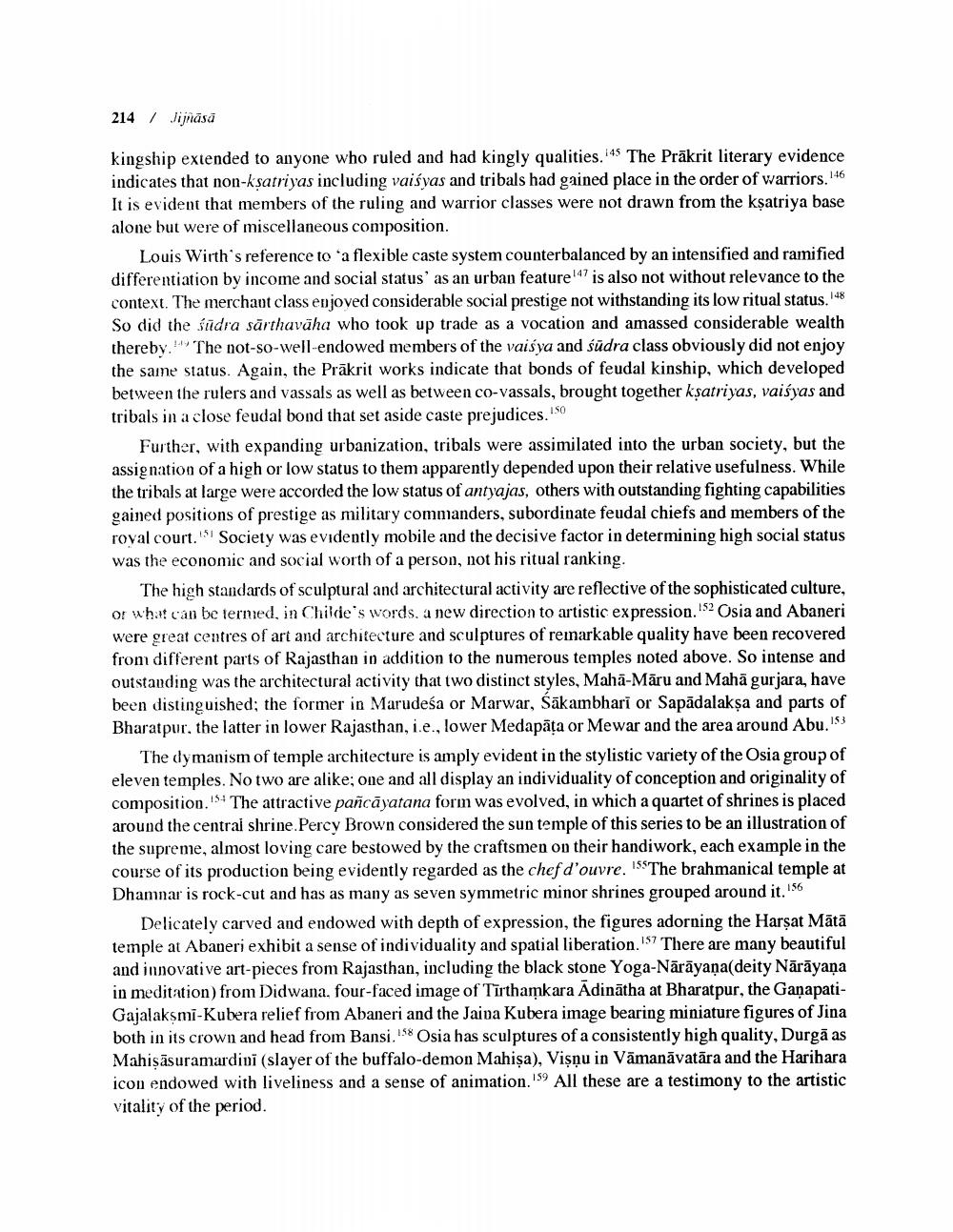________________
214
/ Jijrāsa
kingship extended to anyone who ruled and had kingly qualities.145 The Prākrit literary evidence indicates that non-ksatriyas including vaisyas and tribals had gained place in the order of warriors.146 It is evident that members of the ruling and warrior classes were not drawn from the ksatriya base alone but were of miscellaneous composition.
Louis Wirth's reference to a flexible caste system counterbalanced by an intensified and ramified differentiation by income and social status' as an urban feature 47 is also not without relevance to the context. The merchant class enjoved considerable social prestige not withstanding its low ritual status.148 So did the sūdra sārthavāha who took up trade as a vocation and amassed considerable wealth thereby." The not-so-well-endowed members of the vaisya and südra class obviously did not enjoy the same status. Again, the Prākrit works indicate that bonds of feudal kinship, which developed between the rulers and vassals as well as between co-vassals, brought together ksatriyas, vaisyas and tribals in a close feudal bond that set aside caste prejudices.
Further, with expanding urbanization, tribals were assimilated into the urban society, but the assignation of a high or low status to them apparently depended upon their relative usefulness. While the tribals at large were accorded the low status of antyajas, others with outstanding fighting capabilities gained positions of prestige as military commanders, subordinate feudal chiefs and members of the royal court. Society was evidently mobile and the decisive factor in determining high social status was the economic and social worth of a person, not his ritual ranking.
The high standards of sculptural and architectural activity are reflective of the sophisticated culture, or what can be terned, in Childe's words, a new direction to artistic expression.12 Osia and Abaneri were great centres of art and architecture and sculptures of remarkable quality have been recovered from different parts of Rajasthan in addition to the numerous temples noted above. So intense and outstanding was the architectural activity that two distinct styles, Mahā-Māru and Mahā gurjara, have been distinguished; the former in Marudeśa or Marwar, Sākambhari or Sapādalakṣa and parts of Bharatpur, the latter in lower Rajasthan, i.e., lower Medapāta or Mewar and the area around Abu. 153
The dymanism of temple architecture is amply evident in the stylistic variety of the Osia group of eleven temples. No two are alike; one and all display an individuality of conception and originality of composition. 54 The attractive pañcāyatana form was evolved, in which a quartet of shrines is placed around the central shrine. Percy Brown considered the sun temple of this series to be an illustration of the supreme, almost loving care bestowed by the craftsmen on their handiwork, each example in the course of its production being evidently regarded as the chef d'ouvre. 15The brahmanical temple at Dhamnar is rock-cut and has as many as seven symmetric minor shrines grouped around it.156
Delicately carved and endowed with depth of expression, the figures adorning the Harsat Mātā temple at Abaneri exhibit a sense of individuality and spatial liberation.157 There are many beautiful and innovative art-pieces from Rajasthan, including the black stone Yoga-Nārāyaṇa(deity Nārāyana in meditation) from Didwana four-faced image of Tīrthamkara Adinātha at Bharatpur, the GanapatiGajalaksmi-Kubera relief from Abaneri and the Jaiva Kubera image bearing miniature figures of Jina both in its crown and head from Bansi 158 Osia has sculptures of a consistently high quality, Durgā as Mahişāsuramardini (slayer of the buffalo-demon Mahisa), Vişnu in Vāmanāvatāra and the Harihara icon endowed with liveliness and a sense of animation.159 All these are a testimony to the artistic vitality of the period.




